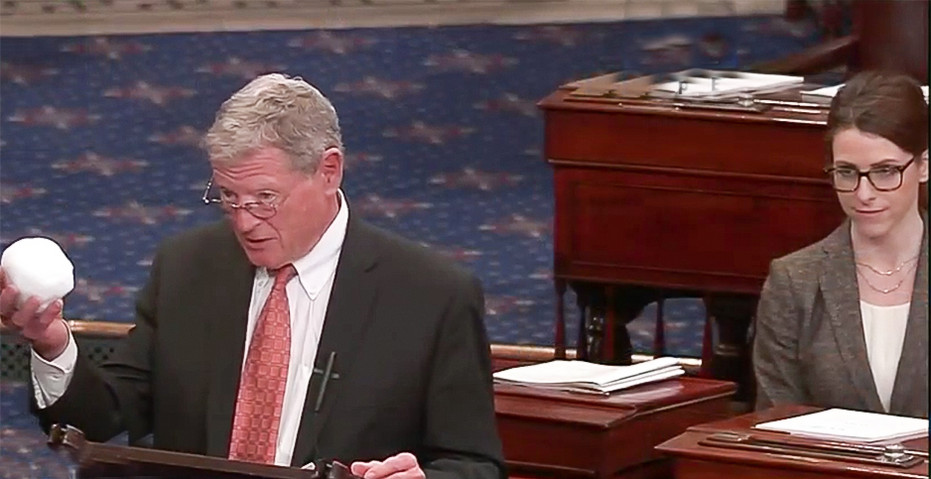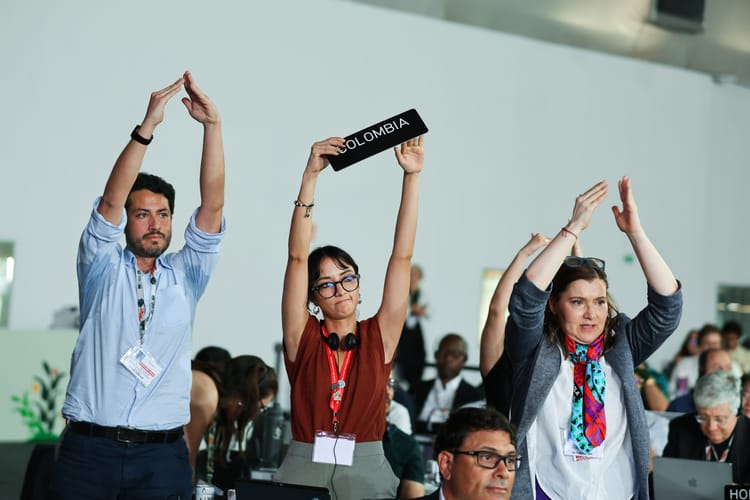Everything You Need to Know About Project 2025's Plan for the EPA

If you browse the Internet or watch TV you've probably heard of Project 2025, the blueprint for a second Trump presidency, mapped out by a coalition of 100 conservative think tanks, spearheaded (publicly at least) by the Heritage Foundation. Nothing written down in the Project 2025 manifesto is new, per se, nor is it new that they've written it down. Heritage put out a similar "Mandate for Leadership" in 2016, gearing up for the first Trump term. For that matter, they've been putting these things out regularly since Reagan.
It is updated, though, and it's handy to have it all written out, side by side, a clear window into what lies behind the door on the right.
I know this newsletter has not been publishing as consistently as usual; partly that's because I've been reading this thing (partly it's because I've been working on a story about carbon capture that's making my head explode, which should be out in the next week or so). One thing I think is important to note is that once again we see that those pushing against climate action are not just aligned with those attacking trans rights, racial justice, labor rights and reproductive rights, but are in the same organizations, being funded by the same universe of backers.

The complete Project 2025 manifesto is 900 pages (?!!), which might explain why it sometimes feels like we're hearing about this thing all the time yet don't know much about it. I haven't quite finished it yet, but I have managed to get to page 500, including Chapter 13, in which the plan for the Environmental Protection Agency is laid out.
The first thing I noticed is the chapter's author: Mandy Gunesakara. Today, Gunesakara is a visiting fellow in the Heritage Foundation’s Center for Energy, Climate, and Environment and senior policy analyst for the Independent Women's Forum, a conservative women's organization funded by the Bradley Foundation, Sarah Scaife Foundation, and the Koch-backed donor-advised fund Donors Trust. A lawyer by training, Gunesekara has previously been a member of the CO2 Coalition (you might recognize her as the Republican witness during Rep Jamie Raskin's 2019 Subcommittee on Civil Rights and Civil Liberties' hearing on "The Oil Industry's Efforts to Suppress the Truth about Climate Change"), worked for Trump's EPA (first as principal deputy assistant administrator at the EPA’s Office of Air and Radiation and then as chief of staff to EPA Administrator Andrew Wheeler), where she claims to have been "the chief architect of the Paris Accord withdrawal and the repeal of the Clean Power Plan", and was famously the Senator James Inhofe staffer who handed him a snowball during a 2015 hearing in which he claimed the existence of snow meant global warming wasn't a problem. She was Majority Counsel for Inhofe, and led committee actions and policy development on Clean Air Act and climate change issues.

It would not be remotely surprising to see Gunasekara tapped as EPA chief in a Trump administration. Following is a rundown of her key proposals. It's a long read, but not 32-pages long, so...you're welcome?
Thanks for reading! Out now on the podcast, another story from our "The Real Free Speech Threat" season, this time about how El Salvador's "cool dictator" Nayib Bukele is going after anti-mining activists to clear a path for lifting the country's mining ban:
Want to support our work? Consider upgrading to a paid subscription today!
First, the broad strokes. A Trump EPA would:
- Cut any program focused on climate (including climate czars);
- Limit the agency's ability to regulate under both the Clean Air Act and Clean Water Act;
- "Pause for review" (aka cut) anything that references "environmental justice" (because "reverse racism") and eliminate the stand-alone Office of Environmental Justice and External Civil Rights;
- Push through the "Secret Science" proposal that didn't quite make it last time around, which specifically targets the long-term epidemiological studies that linked air pollution to shorter lives and were used to justify air-quality regulations;
- Politicize the agency, giving all authority to political appointees over scientists;
- Shrink and de-fund the agency;
- Cut EPA funding of university research
- Move away from anything supporting energy transition
- Move away from regulating pesticides and agrichemcials
Now, the details...
Climate and Air Pollution Go Hand in Hand
I've written before about Steve Milloy, the tobacco and coal lobbyist, and his longtime war on air pollution regulations. This proposal has his fingerprints all over it. Which makes sense for a few reasons: First, Gunasekara has no scientific background whatsoever, so she'd need someone like Milloy to outline a plan like this. Milloy got a BA in natural sciences and then a masters in biostastics from Johns Hopkins University. Although he's never actually worked as a scientist, those qualifications still make him uniquely science-y in the climate denier-sphere. Milloy went to Georgetown law school after Johns Hopkins, had a brief stint at the Securities Exchange Commission and then got a job with infamous industry lobbyist Jim Tozzi after he “ran into” him one day. “He had an unusual lobbying practice where he lobbied regulatory agencies, so he hired me to work on risk issues because of my background in biostatistics and law,” Milloy told me.
Gunasekara and Milloy have both been visiting fellows at the Heritage Foundation, and Milloy was on the Trump EPA transition team when Gunasekara was an early appointee for the agency. "I was the only person on the team with a background in EPA science, so I was brought on to write the science part of the transition plan,” Milloy told me in 2020.
That "background in EPA science" came during the 90s, when Milloy was between stints as the science policy director for the National Environmental Policy Institute, a lobbying group funded by Occidental Petroleum and a handful of other oil companies that aimed to roll back EPA Superfund rules, and working as the director of the The Advancement of Sound Science Coalition (TASSC), an organization Tozzi worked with PR firm APCO to create for Philip Morris that aimed to poke holes in the science linking smoking, and particularly secondhand smoke, to cancer.
In between those gigs, “I got a big contract from DOE to study whether EPA science was based on science or politics,” Milloy said. That was the DOE's Regulatory Impact Project, Inc., which had hired Milloy to work on other studies, too. “I got the contract under Bush and finished under Clinton, and when the report was done and I sent it up the line to DOE, which was now all Clinton appointees. They said I couldn’t publish it, because I said regulations were based on politics and not science. So, I decided to cut my contract and publish it on my own. It got picked up in the Wall Street Journal and that’s what sort of launched me into whatever I am today.”
He’s never stopped trying to reshape the EPA the way he initially recommended in that report, back in the mid-1990s. And he's never stopped fighting air pollution regulations either, or warning conservatives and fossil fuel executives that regulating air pollution “is the most important backdoor science scheme for regulating fossil fuel emissions,” as he put it to me. Both of these crusades factor heavily into Gunasekara's Project 2025 EPA chapter.
In it, she proposes that the EPA embrace “true transparency” and “open-source science,” clear nods to Milloy’s “secret science” proposals for anyone who’s ever read them. To accomplish this, Gunasekara says the EPA must:
- “Shift responsibility for evaluating misconduct away from its Office of Scientific Integrity, which has been overseen by environmental activists, and toward an independent body.”
- “Work (including with Congress) to provide incentives similar to those under the False Claims Act for the public to identify scientific flaws and research misconduct, thereby saving taxpayers from having to bear the costs involved in expending unnecessary resources.”
- Avoid proprietary, black box models for key regulations. Nearly all major EPA regulations are based on nontransparent models for which the public lacks access or for which significant costs prevent the public from understanding agency analysis.
She goes after air pollution regulations from multiple angles too (all while proclaiming that a “conservative EPA” will provide cleaner air, water and soil, mind you), proposing reforms for the Office of Air and Radiation—where she once worked, during the Trump administration—as well as changes to National Ambient Air Quality Standards (NAAQS) and the Clean Air Scientific Advisory Committee that helps to set them, and proposing limits to the application of the Clean Air Act.
A Trump EPA Won't Just Not Regulate Greenhouse Gas Emissions, It Will Work to Make it Impossible for Any EPA to Regulate Them
It's not at all surprising that this proposal aims to cut any EPA program focused on dealing with climate change. Nor is it shocking to read lines that sound like they were lifted from an early aughts climate denial blog swimming in Tea Party memes, like this gem: “Mischaracterizing the state of our environment generally and the actual harms reasonably attributable to climate change specifically is a favored tool that the Left uses to scare the American public into accepting their ineffective, liberty-crushing regulations, diminished private property rights, and exorbitant costs."
Where Project 2025 takes things a step further than one might expect is in its proposals to hamstring any future efforts to curb greenhouse gas emissions, too.
Gunasekara wants to "notify Congress that EPA will not conduct any ongoing or planned science activity for which there is not clear and current congressional authorization," for a start, calling to mind the 2022 Supreme Court ruling in West Virginia v EPA, when justices invoked the "major questions doctrine," arguing that unless Congress explicitly moves to regulate greenhouse gases, and gives the power to do so to the EPA, the agency shouldn't even think about it.
She also wants to "eliminate the use of unauthorized regulatory inputs like the social cost of carbon, black box and proprietary models, and unrealistic climate scenarios, including those based on Representative Concentration Pathway (RCP) 8.5."
RCP 8.5 is one of the projected future scenarios mapped out by climate scientists in reports from the Intergovernmental Panel on Climate Change. While those in favor of increasing development of fossil fuels, like Gunasekara, dismiss it as "unrealistic" or a "worst-case scenario," actual scientists debate the details but generally take the projection seriously. Some argue that RCP 8.5 may actually underestimate future concentrations of atmospheric carbon on the business-as-usual path. Others describe RCP 8.5 concentrations as unlikely, yet plausible, on the business-as-usual path and note that RCP 8.5 is consistent with the current pace of global emissions. And still others think the anthropogenic emissions associated with RCP 8.5 are unlikely, but only because they say increased coal energy usage would run counter to current energy transition trends. The IPCC itself reports that “Scenarios without additional efforts to constrain emissions (‘baseline scenarios’) lead to pathways ranging between RCP6.0 and RCP8.5.”
Elsewhere in the chapter, Gunasekara writes about wanting to "limit EPA’s reliance on Clean Air Act section 30121 general rulemaking authority to ensure that it is not abused to issue regulations for which EPA lacks substantive authority elsewhere in the statute," another clear attempt to block the agency's ability to do anything about greenhouse gas emissions. In other sections she's more explicit, writing that the agency should "remove the Greenhouse Gas Reporting Program (GHGRP) for any source category that is not currently being regulated," calling it a "significant burden" on small businesses. She also suggests the agency "update the 2009 endangerment finding," referring to the agency's finding under Clean Air Act section 202(a) that greenhouse gases in the atmosphere endanger both the public health and the environment for current and future generations. The chapter also recommends repealing some of the regulations on hydrofluorocarbons, and changing course on how transportation emissions are dealt with, proposing a lifecycle analysis of electric vehicles; integrating cost, choice and other non-environmental concerns into the agency's greenhouse gas car standards; and walking back efforts to monitor or regulate air travel and truck emissions.
The EPA Is Too Political! Put Political Appointees In Charge of Everything
For all its squawking about how the EPA has been politicized, P2025 recommends putting political appointees in charge of:
- the Office of Transportation and Air Quality (OTAQ);
- the Office of Air Quality Planning and Standards (OAQPS);
- a newly elevated American Indian Office (AIO), to be headquartered in an oil and gas region (Oklahoma, Texas and Colorado are recommended);
- the Office of Research & Development, where Gunasekara recommends appointing and empowering a Science Adviser reporting directly to the Administrator in addition to a substantial investment (no fewer than six senior political appointees) charged with overseeing and reforming EPA research and science activities. "Qualifications for these positions should emphasize management, oversight, and execution skills (including in leading state environmental agencies) as opposed to personal scientific output." Yes, god forbid we put scientists in charge of the science.
- establishing a political Chief of Staff to oversee the air office in general and requiring regional offices to receive approval from them for enforcement actions;
- pulling the Renewable Fuel Standard out of the OTAQ into its own sub-office, run by a political appointee; (and establish a Memorandum of Understanding with the Department of Agriculture and the Department of Energy to work together to establish RFS programs. Hello, ethanol!)
Also throughout this chapter, Gunasekara suggests cutting the federal EPA budget and giving the states more power, while also mapping out a system in which state and regional EPAs are entirely under the control of political appointees. The section on the EPA's legal counsel, for example, recommends that the agency “establish a policy of legally speaking with one voice,” and notes: “Some EPA offices (for example, the Office of Enforcement and Compliance Assurance and the Offices of Regional Counsel) assert legal positions and interpretations of the law that conflict with an Administration’s interpretation as articulated by the Office of General Counsel with input from program offices." These "inconsistent legal positions"are deemed unacceptable, and it's recommended that all attorneys with authority to represent the EPA be housed at the federal level (under a political appointee) in the Office of General Counsel.
Environmental Justice Is Reverse Racism
If ever there was a crystal-clear example of why it's important for anyone concerned about acting on climate to tune in to and join social justice fights, the intersection between efforts to push against diversity and inclusion and those to block climate policy is it. Over the past year or so, a slew of court cases have argued that initiatives meant to support diversity—in the workplace, at universities, in investments—discriminate against white people. A dozen or so of these cases have been brought by many of the same groups that are on Project 2025's advisory board, organizations like America First Legal Foundation, which is led by former Trump advisor Stephen Miller, and the Alliance Defending Freedom.
Funding for the litigation comes from various other Project 2025 organizations, many of which also fed the original attempt to create a legal basis for “reverse racism” claims in the 90s: the Bradley Foundation, the Koch network, and Pacific Legal Foundation (which is connected to the Atlas Network of libertarian think tanks), now joined by billionaire Barre Seid, who’s former Federalist Society president and longtime conservative legal activist Leonard Leo's new benefactor. Their collective pockets contain more than enough to, as Leo put it last year, “flood the zone with cases.”
Over the past year, the fight against diversity and the fight against climate policy have joined forces in the fight against the most boring of all opponents: investment risk disclosure. Specifically, environmental, social, and governance (ESG) risk disclosure, which spent its first 20 or so years of existence being at worst ignored, and often embraced by companies that used social responsibility reports to boost their brands and unlock capital from do-gooder investors.
The various segments on environmental justice in Project 2025's EPA chapter echo the same arguments in the anti-ESG fight against "woke capital" and the anti-DEI cases crying "reverse racism." It recommends pausing or cutting all environmental justice-focused programs that were established or expanded under Biden and emphasizes the need to make sure they are being based on “neutral constitutional principles.”
It specifically cites cases various Project 2025 organizations have brought or participated in “The next Administration should pause and review all ongoing EJ and Title VI actions to ensure that they are consistent with any forthcoming SCOTUS decision.”
And lest there be any confusion, the summary at the start of the chapter explicitly recommends "eliminating the stand-alone Office of Environmental Justice and External Civil Rights."
This Week's Climate Must-Reads
- UN attacks companies’ reliance on carbon credits to hit climate targets, by Kenza Bryan for the Financial Times - As the world continues to wait on whether the Science-Based Targets Initiative (SBTI) will opt to open the floodgates to corporations using carbon offsets to hit their net zero targets or not, a draft document seen by the Financial Times and drawn up by a task force convened by UN secretary-general António Guterres has weighed in saying they should actually curb emissions and if they must add offsets to the mix, ought to avoid the private carbon offset market altogether.
- Where Harris and Her Potential Running Mates Stand on Climate Change, by Matthew Griffin, Alexander Battle Abdelal, and Leslie Kaufman for Bloomberg - With Biden out and Harris having secured the Democratic nomination, a slew of stories were out this week looking at how the changed ticket might impact climate policy. I found Bloomberg's roundup the most comprehensive and helpful.
- Climate hasn't been core to the GOP. These conservatives are trying to change that, by Ximena Bustillo for NPR - I don't usually go in for "they're conservative but they care about climate" stories, just because they all tend to tell the same story about planting a bunch of trees. This one is a fascinating look at the group that brought a climate presence to the RNC for the first time in decades.
- ‘Not acceptable in a democracy’: UN expert condemns lengthy Just Stop Oil sentences, by Damien Gayle, Helena Horton and Ben Quinn for The Guardian - UN special rapporteur for environmental defenders, Michel Forst, has officially condemned the sentencing of five Just Stop Oil activists (including the group's founder Roger Hallam) to multi-year prison sentences for planning non-violent protests on the M25, joining an increasingly loud chorus.
- Billions in US funding boosts lithium mining, stressing water supplies, by Elyse Hauser for Floodlight - A deep dive on how the Inflation Reduction Act is supporting lithium mining and where that's causing environmental issues.





